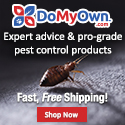Alternatives to Mothballs
-- Use alternatives to these highly toxic materials --
Summary: Mothballs are made from two very volatile toxic chemicals. These chemicals are dangerous even at very low concentrations. At concentrations high enough to be effective pest control agents they become extremely hazardous. As such we no longer recommend that mothballs be used for household pests such as carpet beetles and clothes moths, or indeed any other pest control task. There are now safer and more effective alternative treatments.
Mothballs are extremely toxic!
Mothballs are made of white crystals of one or two very dangerous chemicals, para-dichlorobenzene (1,4-dichlorobenzene) and/or naphthalene. Both chemicals are solid at room temperature but produce very strong, toxic vapors. Mothballs are generally sold as flakes or pressed into cakes or balls.
Both of these chemicals are fumigants and the vapors must be present in high concentration to be effective, and this is the problem. Concentrations high enough to be effective for pest control can be dangerous for anyone exposed to them.
Some people use mothballs to ward off insect pests that damage clothes, such as carpet beetles and clothes moths, and as a deterrent to some landscape pests. They are often used in large amounts which exposes people to high concentrations of these very dangerous compounds.
One of the ingredients, para-dichlorobenzene, may be a carcinogen and may also damage the liver and kidneys at high doses. And, naphthalene can damage the liver and cause eye injury. Mothballs can be especially dangerous if accidentally eaten. In short, mothballs should not be used by homeowners.
If they are used, and unfortunately I know that some people will continue to use them, they should only be used sparingly and anything stored around mothballs should be thoroughly cleaned. Dry clean wool and silk articles or wash other fabrics to remove all mothball smell before use.
Alternatives to mothballs
There are very effective alternatives to mothballs for clothes moths and carpet beetles. The most important point to remember about clothes moths is that soiled cloth is much more likely to become infested. Do not put clothes that have been worn into long-term storage without first cleaning them. Dry cleaning is the most effective method for removing eggs and larvae of insect pests.
Store clean clothes in plastic bags or boxes that are tightly sealed. Be cautious of imported wool textiles since they may already be infested. Dry clean any soiled item before you bring it home. Infested drawers and closets should be completely emptied and wiped down with a mild solution of household cleaner. Dry clean all wool or silk articles, non-wool or silk articles can be washed and dried under heat. See How to Manage Clothes Moths and How to Manage Carpet Beetles for specific information about eliminating these pests in your home.
Also, you might want to check out the dangers of mothballs at National Institute of Environmental Health Sciences (you will need to search on the term "mothballs").
Cedar chests and cedar-lined closets
You might be tempted to try cedar oil as an alternative to mothballs. Be aware that at concentrations present in cedar chests, closets and scented wood blocks, cedar oil has almost no value as moth or beetle repellents. The value of a cedar chest is that the chest is tightly closed, thus preventing entry of moths or beetles. So enjoy the aroma of your cedar but don't expect it to chase away any bugs!
Supplies
Professional-level pest control supplies are generally not available in home and garden stores but can be found at DoMyOwn.com, our affiliate.

How to search 'Bugs for more information
The easiest way is to open a Google search page and type: "your query" + site:livingwithbugs.com into the search box. For example, to find all 'Bugs articles about carpenter ants type: carpenter ants + site:livingwithbugs.com in the search box.
The resulting list of pages may contain some Google advertising (marked with "Ad" next to the URL) as well relevant pages from 'Bugs. The ads do not originate with 'Bugs.
